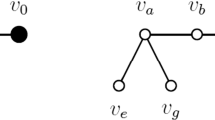Abstract
Given a set of n sites in the plane, the order-k Voronoi diagram is a planar subdivision such that all points in a region share the same k nearest sites. The order-k Voronoi diagram arises for the k-nearest-neighbor problem, and there has been a lot of work for point sites in the Euclidean metric. In this paper, we study order-k Voronoi diagrams defined by an abstract bisecting curve system that satisfies several practical axioms, and thus our study covers many concrete order-k Voronoi diagrams. We propose a randomized incremental construction algorithm that runs in \(O(k(n-k)\log ^2 n +n\log ^3 n)\) steps, where \(O(k(n-k))\) is the number of faces in the worst case. This result applies to disjoint line segments in the \(L_p\) norm, convex polygons of constant size, points in the Karlsruhe metric, and so on. In fact, a running time with a polylog factor to the number of faces was only achieved for point sites in the \(L_1\) or Euclidean metric before.








Similar content being viewed by others
Notes
Actually, the number of times does not matter. It is sufficient that the size of the sequence of sub-faces is proportional to the size of the boundary of F.
References
Agarwal, P.K., de Berg, M., Matousek, J., Schwarzkopf, O.: Constructing levels in arrangements and higher order Voronoi diagrams. SIAM J. Comput. 27(3), 654–667 (1998)
Aurenhammer, F., Schwarzkopf, O.: A simple on-line randomized incremental algorithm for computing higher order Voronoi diagrams. Int. J. Comput. Geom. Appl. 2(4), 363–381 (1992)
Bohler, C., Cheilaris, P., Klein, R., Liu, C.-H., Papadopoulou, E., Zavershynskyi, M.: On the complexity of higher order abstract Voronoi diagrams. Comput. Geom. 48(8), 539–551 (2015)
Bohler, C., Klein, R.: Abstract Voronoi diagrams with disconnected regions. Int. J. Comput. Geom. Appl. 24(4), 347–372 (2014)
Bohler, C., Klein, R., Liu, C.-H.: An efficient randomized algorithm for higher-order abstract Voronoi diagrams. In: Proceeding of the 32nd International Symposium on Computational Geometry (SoCG 2016), pp. 21:1–21:15 (2016)
Bohler, C., Liu, C.-H., Papadopoulou, E., Zavershynskyi, M.: A randomized divide and conquer algorithm for higher-order abstract Voronoi diagrams. Comput. Geom. 59, 26–38 (2016)
Boissonnat, J.-D., Devillers, O., Teillaud, M.: A semidynamic construction of higher-order Voronoi diagrams and its randomized analysis. Algorithmica 9(4), 329–356 (1993)
Chan, T.M.: Random sampling, halfspace range reporting, and construction of (\(\le k\))-levels in three dimensions. SIAM J. Comput. 30(2), 561–575 (2000)
Chan, T.M., Tsakalidis, K.: Optimal deterministic algorithms for 2-d and 3-d shallow cuttings. Discrete Comput. Geom. 56(4), 866–881 (2016)
Chazelle, B.: Triangulating a simple polygon in linear time. Discrete Comput. Geom. 6, 485–524 (1991)
Chazelle, B., Edelsbrunner, H.: An improved algorithm for constructing \(k\)-th-order Voronoi diagrams. IEEE Trans. Comput. 36(11), 1349–1354 (1987)
Chazelle, B., Edelsbrunner, H., Guibas, L.J., Sharir, M., Snoeyink, J.: Computing a face in an arrangement of line segments and related problems. SIAM J. Comput. 22(6), 1286–1302 (1993)
Chew, L.P., Scot Drysdale, R.L.: Voronoi diagrams based on convex distance functions. In: Proceedings of the First Annual Symposium on Computational Geometry, (SoCG 1985), pp. 235–244 (1985)
Clarkson, K.L.: New applications of random sampling in computational geometry. Discrete Comput. Geom. 2, 195–222 (1987)
Clarkson, K.L., Shor, P.W.: Application of random sampling in computational geometry, II. Discrete Comput. Geom. 4, 387–421 (1989)
Gemsa, A., Lee, D.T., Liu, C.-H., Wagner, D.: Higher order city Voronoi diagrams. In: Proceedings of the 13th Scandinavian Symposium and Workshops on Algorithm Theory (SWAT), pp. 59–70 (2012)
Haussler, D., Welzl, E.: Epsilon-nets and simplex range queries. Discrete Comput. Geom. 2, 127–151 (1987)
Klein, R.: Voronoi diagrams in the Moscow metric (extended abstract). In: Proceedings of the 14th International Workshop of Graph-Theoretic Concepts in Computer Science (WG88), pp. 434–441 (1988)
Klein, R.: Concrete and Abstract Voronoi Diagrams. Volume 400 of Lecture Notes in Computer Science. Springer, Berlin (1989)
Klein, R., Langetepe, E., Nilforoushan, Z.: Abstract Voronoi diagrams revisited. Comput. Geom. 42(9), 885–902 (2009)
Klein, R., Mehlhorn, K., Meiser, S.: Randomized incremental construction of abstract Voronoi diagrams. Comput. Geom. 3, 157–184 (1993)
Lee, D.T.: On k-nearest neighbor Voronoi diagrams in the plane. IEEE Trans. Comput. 31(6), 478–487 (1982)
Liu, C.-H., Lee, D.T.: Higher-order geodesic Voronoi diagrams in a polygonal domain with holes. In: Proceedings of the Twenty-Fourth Annual Symposium on Discrete Algorithms (SODA), pp. 1633–1645 (2013)
Mehlhorn, K., Meiser, S., Rasch, R.: Furthest site abstract Voronoi diagrams. Int. J. Comput. Geom. Appl. 11(6), 583–616 (2001)
Mulmuley, K.: Computational Geometry: An Introduction Through Randomized Algorithms. Prentice Hall, Englewood Cliffs (1994)
Papadopoulou, E.: The Hausdorff Voronoi diagram of point clusters in the plane. Algorithmica 40(2), 63–82 (2004)
Papadopoulou, E., Zavershynskyi, M.: On higher order Voronoi diagrams of line segments. Algorithmica 74(1), 415–439 (2016)
Ramos, E.A.: On range reporting, ray shooting and k-level construction. In: Proceedings of the Fifteenth Annual Symposium on Computational Geometry (SoCG), pp. 390–399 (1999)
Tarjan, R.E., Van Wyk, C.J.: An \(O(n \log \log n)\)-time algorithm for triangulating a simple polygon. SIAM J. Comput. 17(1), 143–178 (1988)
Acknowledgements
We deeply appreciate all valuable comments from the anonymous reviewers for SoCG 2016 and Algorithmica.
Author information
Authors and Affiliations
Corresponding author
Additional information
Publisher's Note
Springer Nature remains neutral with regard to jurisdictional claims in published maps and institutional affiliations.
A preliminary version appeared in Proceedings of International Symposium on Computational Geometry (SoCG) 2016 [5]. This work was supported by Deutsche Forschungsgemeinschaft (DFG Kl 655/19) in a DACH Project.
Rights and permissions
About this article
Cite this article
Bohler, C., Klein, R. & Liu, CH. An Efficient Randomized Algorithm for Higher-Order Abstract Voronoi Diagrams. Algorithmica 81, 2317–2345 (2019). https://doi.org/10.1007/s00453-018-00536-7
Received:
Accepted:
Published:
Issue Date:
DOI: https://doi.org/10.1007/s00453-018-00536-7




